#mai-1604
Note
sorry if you've already answered this but i just read your post about whipping girl and found it so so so insightful!! i was wondering if you have any other recommendations for books/articles/etc. about transmisogyny and the lives of tma people. thank you in advance!!
I'm glad it was helpful! this is the second ask on the subject I've let pile up, because I want to do my best with it but I'm also far from an expert. I think half the work of answering "transmisogyny syllabus" questions is explaining why it's so hard to do so in the first place.
one of the tools of hegemony is the epistemic violence it works against its subjects; this is essential to transmisogyny, thru which we have historically been rendered unable to so much as record our existence, let alone theorize from it. it is incredibly difficult for a tma person to access the institutional devices of knowledge-making, most of all the university. even when we do it is typically for the institutions we work under to shoehorn our work into the hegemonic model, stymieing actual progress. so theories and histories of transmisogyny have had to progress in a patchwork, often informal fashion, upstream and at personal risk. I am not going to be able to give you books that I would recommend without criticism, because the epistemic violence of transmisogyny has made it virtually impossible to write such a book. but with that said, here are some recommendations:
- this post multiplied my understanding of transmisogyny manifold, and was one of the most clarifying things I've read on the subject
- hands off our lives, our stories, and our bodies, is imo essential to anyone interested in a theory of transmisogyny that actually engages with its manifestations in the global south
- I enjoyed My Words to Victor Frankenstein above the Village of Chamounix: Performing Transgender Rage by Susan Stryker for the vibes
- two historical excavations of transmisogyny: Trans Misogyny in the Colonial Archive: Re-Membering Trans Feminine Life and Death in New Spain, 1604–1821 by Jamey Jesperson and ‘Selective Historians’: The Construction of Cisness in Byzantine and Byzantinist Texts by Ilya Maude
- Romancing the Transgender Native is good for learning the trappings of ahistorical and idealist "third gender" attributions
- especially (but not exclusively) if you are yourself a trans woman/transfem/tma, consider reading fiction by trans women/tma people, like Serious Weakness by Porpentine Charity Heartscape (check tws) or LOTE by Shola von Reinhold
- Jules Gill-Peterson's A Short History of Trans Misogyny is great for some case studies in global transmisogyny, and a decent materialist approach. but I think she makes the same mistake serano made re: equivocation of transmisogyny with the oppression of femininity, and she would have done well to read the second article on this list. her histories of the transgender child is also good, though not especially focussed on transmisogyny
- follow @ bloomfilters on twitter
if this looks like a hodgepodge that's because it is on account of what I said in the first two paragraphs. I am really not an expert and I am sure there are others who could give you much more. but to echo a friend, you may be just as likely to get something out of a game or a song written by a tma person as you are an essay. every medium can be an opportunity to plunge the roots of our theorizing deeper.
#ask answer#transmisogyny#just finished a short history today maybe i will post a short review at some point#when my makes you sleepy meds stop making me sleepy
288 notes
·
View notes
Text
To the Nonnie who asked me about the Druze and Bedouins in Israel, here's a recounting of the history of these two communities here.
The Druze in Israel
The Druze are members of an ethno-religion that split from Shiite-Isma'ili Islam in the 11th century in Egypt. For a while, people could join the Druze faith, but then that period was over, and since then, you can't convert to become a Druze. In order to maintain their ethno-religious group, they're not supposed to marry non-Druze. Most of the Druze originate and live in Syria, with small numbers in southern Lebanon and in northern Israel.
Most of the Druze who came to live in Israel, did so in the 16th and 17th centuries, when the Ma'an Druze rulers of Lebanon rebelled against the Ottoman (Turkish) Empire, and occupied northern Israel. Along the years, the Druze repeatedly attacked and stole from Israel's Jews. In the northern city of Safed, for example (one of the four holy Jewish cities, considered holy for ALWAYS having had Jewish presence, no matter what happened to Jews in Israel), notable Druze attacks against Jews happened in 1567, 1604, 1628, 1656 and 1838.
When did this change, and the relationship between the Jewish and Druze residents of the Land of Israel become better? Well, in 1936-1939, as Muslim Arabs in Israel (inspired by their antisemitic leader Haj Amin al-Husseini) attacked the Jews and the British in what came to be known as "The Arab Revolt," they also attacked the Druze, who intended to remain neutral in the fight between the Arabs and Jews. There were some Druze who did join Arab forces attacking Jews. Probably the most prominent Arab militia the Druze joined was the one led by Yussuf Abu Durra. This man used the opportunity of the revolt to attack Arab and Druze villages, and the latter target made his Druze fighters abandon him, and even start fighting against his militia.
These Arab attacks on the Druze pushed both them and the Jews to forge an actual alliance. Here's the example of the Druze village of Isfiya. It's built on the ruins of an ancient Jewish village, and the name Isfiya is a mispronunciation of the village's original Hebrew name, Husifa. How do we know this original name? Archeological digs in there revealed an ancient Jewish synagogue, with this mosaic, which includes the Hebrew words "Shalom al Yisrael" (peace upon Israel), as well as the name "Husifa":
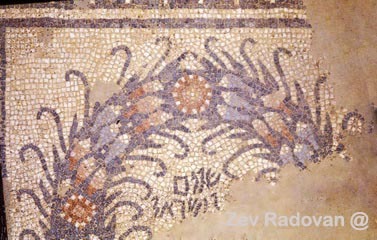
During The Arab Revolt, the village's leaders turned to the adjacent kibbutz Yagur. A Jewish underground movement called Hagana (Hebrew for 'defense,' because it was established 1920 to defend Israel's Jews from Arab attacks) had a group of fighters there, to defend the kibbutz. The Druze asked for the help of the Jews in defending their village from Arab attacks, and the Jews of Yagur agreed. They started collaborating, among other things the Druze provided the Jews with intel, and the Jews provided the Druze with weapons and ammunition. Isfiya's village council ended up incorporating the Jewish synagogue's mosaic into their emblem (this pic is from their Facebook page):
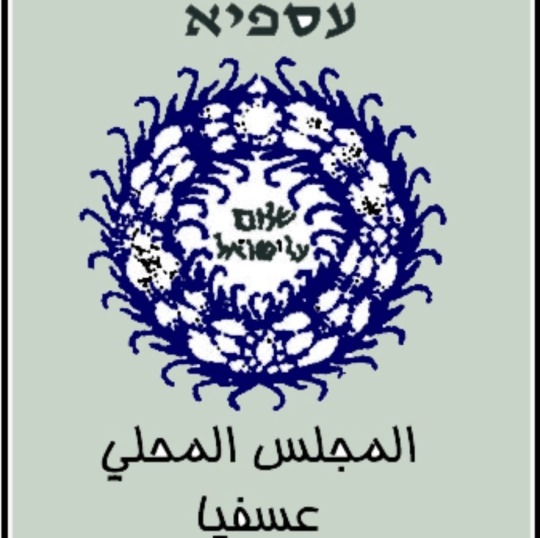
By the end of the revolt in 1939, most of the Druze were on the Jewish side, even if they weren't actively fighting. This opened the path for the same alliance to play a significant role in Israel's War of Independence from Nov 1947 to Jul 1949. There was one Druze unit that fought under Fawzi al-Qawuqji, an Arab commander from Lebanon, who led a militia in Israel during The Arab Revolt, collaborated with the Nazis during WWII, and then led the Arab Liberation Army during Israel's War of Independence War. BTW, this was the antisemitic emblem of the ALA:

Fawzi al-Qawuqji sent his Druze unit to attack the Jews at the Ramat Yochanan battle, on Apr 16, 1948 (meaning, this is during the first stage of the war, when most Arab armies had not yet invaded the Land of Israel. That starts in May 1948). The Druze were defeated, and after that, all of the Druze in Israel were on the Jewish side.
So the answer to what forged the alliance between the Jewish and Druze residents of Israel, is a combination of the Muslim Arabs' violence at the time, and the fact that Jews were no longer a defenseless minority, but got to defend themselves by fighting back. NEVER underestimate the importance of the right to self defense, and the truth is that the only place in the world where Jewish people have this right as Jews is the State of Israel.
When the State of Israel was established, there were 14,500 Druze living here. Today, they number about 150,000 and make up roughly 1.5% of the Israeli population. Back in 1949, Druze service in the Israeli army was strictly voluntary. At the request of Druze leaders in Israel, this was changed in 1956, but the service is mandatory for just the men (while for Israeli Jews, it's mandatory for both men and woman, and for Arabs and Bedouins, it's still voluntary). They're recognized as the most loyal and contributing non-Jewish minority in Israel, and many Druze have reached some of the highest positions of power here.
The Bedouins in Israel
The Bedouins are nomadic tribes, originally native to Arabia (and in fact, while non-nomadic Arabs refer to them as Bedouins, from the Arabic word for 'desert,' they refer to themselves as Arabs, sometimes even as the "real Arabs"). Over the centuries, their routes have continuously expanded, taking them from the deserts of Arabia, through Israel, Jordan and Syria, to northern Africa. A part of what they would often do for a living is connected with herding and commerce, another part is attacking local communities along their wandering routes for loot. Most Bedouins had converted to Islam, and the Islamic conquests coming out of Arabia in the 7th century, taking over the rest of the Middle East, have helped in that expansion of their wandering routes.
In the 19th century, the Ottoman Empire (the Turks) wanted the Bedouins to be more settled, so they would be easier to govern. At the same time, the Ottomans wanted to artificially increase the Muslim population in Israel. So under them, in addition to European converts to Islam (mostly Bosnians and Albanians) settling in Israel, the Ottomans also forced many Bedouins to abandon their nomadic lifestyle and settle in Israel, mostly in the south, in the Negev desert. Some Bedouins completely settled, while some opted for a semi-nomadic life (meaning they still move from where they're staying at least twice a year, but it's not constant wandering, and they move between designated spots, over a relatively small distance).
The exact number of Bedouins in Israel before the establishment of the state is unknown due to the semi-nomadic lifestyle some of them still went by, but estimates are around 110,000 people. During the Independence War, most of the Negev Bedouins fled to Gaza (which came to be occupied by Egypt until 1967). After the state was founded, some returned to Israel. The state established seven villages and a city for them, the only Bedouin city in the world, Rahat (and the biggest Arab city in Israel). Today, the Bedouins in Israel number over 300,000 people in the Negev, about 110,000 people in towns and villages in northern Israel, and over 32,000 living in other cities across the country. They are about 3.5% of Israel's population.
The Bedouins have a more complex relationship with the State of Israel, due to several issues. The state has been seeking solutions for these problems, with varying degrees of success.
One issue is land ownership. You'd think it wouldn't be, with many still being semi-nomadic, but a part of the problem is that more than once, they will simply decide that if they've wandered to a certain spot enough times, it's theirs. In certain cases, these spots are in military zones, which means they're endangering themselves and soldiers by settling there even part time, and the state repeatedly has to evacuate them from those places, including for their own safety. More than once, anti-Israelis will talk about Israel destroying an ancient Palestinian village, and in reality it's a recent Bedouin settlement, where there's no proper infrastructure for them, including for their kids (no water lines, no electricity), and it's in the middle of a dangerous fire zone.
Another issue is polygamy, which is customary among Bedouins, but legally forbidden in the State of Israel. So again, it creates friction between men who want to marry multiple wives, and the authorities.
One more thing is that the traditionally nomadic lifestyle of the Bedouins means they've never really had a history of belonging to specific states, and feeling it's a part of their identity. So they don't feel too obligated to the state and its rule. One example is that they run their own courts. The Ottomans tried to dismantle those, and force the Bedouins to adhere to a Sharia court that they opened in 1906, but when the British took over Israel in 1917 they dismantled it, and allowed the Bedouins to have their courts, out of a colonialist perception that they're too savage to be able to accept western laws. So the Bedouins to this day have issues accepting the authority of the state's courts.
Having said all this, there are also Bedouins who are very loyal to Israel, feeling like the state has drastically improved their life in comparison with how they were treated before (under the British, and before them the Ottomans), or that they have better living conditions than they would have had without the state. Here's one Israeli Bedouin woman, Sophia Khalifa Shramko, speaking about how Israel has bettered their lives:
Also, while most of the Negev Bedouins fled during Israel's War of Independence, there were a few Bedouins from the northern part that fought for the state, and to this day, the northern Bedouins are known as the more loyal faction from among Israeli Bedouins. The state built several permanent settlements for the northern Bedouins, and today they live across 24 communities.
As I mentioned, army service is voluntary for the Bedouins. Over time, it went from a very small number who did serve in Israel's War of Independence, through a big decline in the 1980's, but then since 2002 there's been a small, but steady rise in the number of Bedouins choosing to enlist. In 2003, the first Bedouin woman insisted on serving (she had to fight many in her own society who objected to this, mostly for religious reasons), she succeeded, and opened the path for other Bedouin women to serve as well. There's no official or expert explanation offered for this, but you want my guess? In 2001, Hamas started firing rockets at Israel, and the most targeted are was the Negev, so as Palestinian terrorists made it clear they have no qualms about killing Bedouins simply for being citizens of the Jewish state, my guess is more Bedouins who didn't identify with the state protecting them from Hamas, started to. I think following the Oct 7 massacre, in which at least 19 Bedouins were murdered by Hamas, at least 6 were kidnapped, and dozens are still considered missing, the Bedouins' identification with Israel is at an all time high. We've seen collaborations of Jews helping Bedouins, and Bedouins helping Jews, reaching an unprecedented peak.
Before the Oct 7 attack, the overall number of Bedouins serving was still rather low. In 2021, it was a total of 1,500 people. All the same, Israel has built a special commemoration site for the Bedouin soldiers, including several monuments. Here's one (you can see the Arabic writing at the top if you click the pic):

Israel as the Jewish nation state
The State of Israel is the Jewish nation state. That's not different to other nation states. But I want to emphasize, being a Jewish state, doesn't mean it's a Jew only state. It never was, it was never meant to be, it never will be.
Yes, on the national level, it has Jewish characteristics. The official language is Hebrew, the state calendar follows the Hebrew one, it has Jewish symbols in the flag and state emblem. And Israel also has a law of return for Jews, so they would never have to fear persecution elsewhere ever again. It allowed the saving of Jews from Syria when the civil war started there in 2011, or more recently the war in Ukraine, it allowed Israel to support Jews fleeing rising antisemitism in places like France in the last few decades, and it allows Jews one place where they don't have to constantly adjust themselves to the dominant non-Jewish culture, where they don't have to live by a Christian or Muslim or Buddhist calendar, where they can speak, and consume culture, and create it in their own native language, where they don't have to consider whether they can find a synagogue or kosher food before they move to a certain town, where they get to walk down the same paths their ancestors did thousands of years ago, where they will never be told that Jewish boys wearing a kippah to school is prohibited, and so on.
Every single one of these elements can be found in at least one other country out there, and very much so in nation states. Britain is quite clearly a Christian country when the head of the state is also the head of the church, so is the US when Christmas is a national holiday, but Yom Kippur isn't. Germany is the nation state of the Germans, its language is German (not Turkish, as much as there is a big Turkish community there), the Bundestag, the German parliament building, has a writing dedicating it to "Dem Deutsche Volk" (the German people), and it has a law of return for people of German descent, returning from eastern European countries. In this sense, nothing about Israel as the Jewish nation state is out of the ordinary.
Israel can and should do everything in its power to make life here good for the non-Jewish communities. By law, they have the same civil rights as the Jews. At the same time, these communities actually have less obligations when it comes to army service. Are things perfect? No, and Israel should continue to work on it, always. Just like every country should continuously strive to be better for its minorities. But if the Jewish character of the State of Israel troubles you, ask yourself why are the Jews the only ones not allowed to have a nation state of their own? One place upon the earth, where they're not the minority, in case being a minority elsewhere is something that's become too difficult or too dangerous? Or if they simply want to go back to their roots, to their people and to their ancestral land?
Am Yisrael Chai!
(for all of my updates and ask replies regarding Israel, click here)
#israel#israeli#israel news#israel under attack#israel under fire#terrorism#anti terrorism#antisemitism#hamas#antisemitic#antisemites#jews#jew#judaism#jumblr#frumblr#jewish
175 notes
·
View notes
Text
aftg incorrect quotes as things my professor has said
Neil: thank you, the british
--
Kevin: You're not wrong with it, except completely wrong
--
Wymack: you have to promise not to kill anyone
--
anyone to seth: you may want to consider looking up the wikepedia pate for mysogyny
--
Kevin: Shakespeare since 1604 has just been vibes and men in dresses
--
Wymack: the fact i made it through this class with neil existing just proves I'm a saint
--
Andrew: I didn't mean it as **chokes** you know?
--
Andrew: everyone knows i may burn a house down
#there are many more i wrote down first semester that i cannot find#anyways guess my major#aftg#all for the game#neil josten#allison reynolds#dan wilds#matt boyd#renee walker#aftg andrew#aftg neil#andrew minyard#aftg incorrect quotes#incorrect quotes
118 notes
·
View notes
Text
JAMMF, 303
James Alexander Malcolm Mackenzie Fraser is today 303. Born to both strife and greatness, on Beltane Day.
Fictional characters never die for good, their energy keeps on lingering somewhere, in a corner of our heart. So, here's a heartfelt Happy Birthday to a formidable character that one day chose to possess Herself's imagination and brought us all together, in this strange digital limbo of sorts.
Despite his rock-solid appearance, JAMMF is a real chameleon. My favorite JAMMF is perhaps the least talked about one. The Diplomat. Of course.
This guy, playing chess at Versailles (in reality, it's Prague, and a sizably different kind of Baroque, but let's not nitpick, here). A wonderful metaphor for what diplomacy was, is and always will be: a sophisticated game of chess.

While in Paris, JAMMF is acting, in plain sight, as a diplomatic agent of sorts on behalf of Bonnie Prince Charlie's embryo of a government in exile. Desperately hoping and fruitlessly waiting for more. And making a very bad, emotional job of it all, when emotions are least needed, despite all those best laid plans. Still, he does exactly what a diplomat posted abroad would do. He meets all the important honchos, he brilliantly entertains all those people at his open table, he mingles with princes and beggars alike and of course, he dutifully reports in writing about all this, back to Scotland.
It is, therefore, a pity and a shame that Herself did not utter a single word, in Dragonfly in Amber, about the real Jacobite meeting place in Paris: Sorbonne's Collegium Scoticum/Scots College, or Collège des Écossais, founded in 1333, by an edict of the Parliament of Paris (what we would call today the local council) and as a belated, yet important consequence of the Auld Alliance treaty between France, Scotland and Norway:

This is a place with a rich and minutely documented history, so much so that the adjoining street soon came to be known as the rue des Ecossais (Scots' Street), instead of rue des Amandiers (Almond Tree Street).
The building is still there, albeit with a different destination, a private Catholic elementary school. And a plaque inside the main building tells part of the story, in Latin:
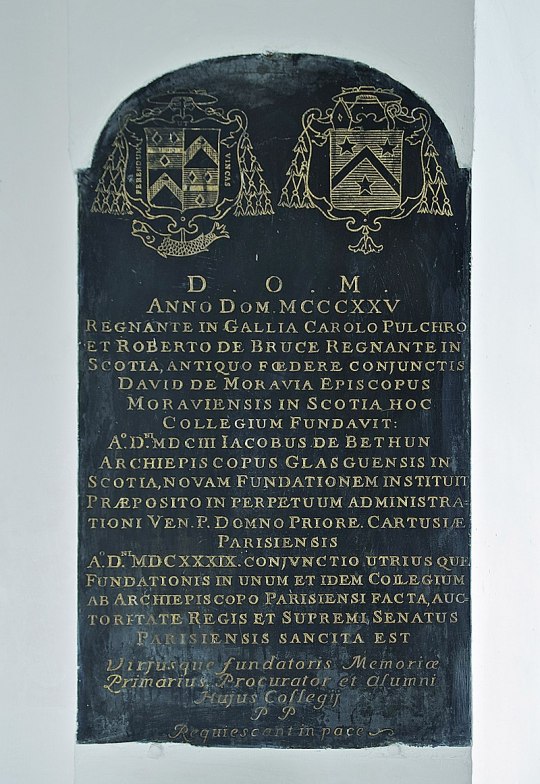
Meaning:
In 1325, under the reigns of Charles the Fair, in France and Robert the Bruce, in Scotland, David de Moravia, bishop of Murray founded this college. In 1604, Jacques de Bethun, archbishop of Glasgow made a seminary out of it, given to the perpetual administration of the Carthusian Order's Superior of Paris [later edit, forgot to translate that properly and the French version I eventually took out is incomplete, sorry!]. In 1639, the whole was placed under the authority of the King of France and the Archbishop of Paris, their supreme authority being solemnly ratified by the Parliament of Paris. In memory of the founders, the priests and the alumni, may they rest in peace!
[Later edit]: the eight year difference in records reflects the time it took for the Parliament of Paris to acknowledge the College's existence and offer its due legal protection. So: founded by the bishop of Murray in 1325 and legally authorized by the Parliament of Paris in 1333. Both dates are legit founding landmarks and can be quoted accordingly.
64 notes
·
View notes
Text
Touhou Project theory: the Scarlet Devil Mansion's heavy metal poisoning
something an intro idk how to do this
WARNING! LONG POST AHEAD!
Potential sources of heavy metal toxins
If we look inside the mansion there's a lot of red carpet. One pigment for red is vermilion, which which is derived from the mercury mineral cinnabar which is highly toxic. Vermilion was a highly valued and prestigious dye historically, befitting of an aristocrat's mansion. Another detail is in one of these screenshots the carpet is a rather dark red, and while many red pigments slowly turn pink as they fade vermilion actually darkens and turns brown (similar to blood), which you can see in the painting below. This could be a lighting effect, though.
Another possible pigment is minium, which is derived from lead and is also toxic.



We also see a fair amount of white in the mansion, on the table cloth in the above image and many of the residents' clothing such as Sakuya's apron and Flandre's mob cap. One historical pigment for white is lead white, which is also derived from lead. Lead white was also used in cosmetics to whiten skin, for another potential source of poisoning.
Another potential source is lead from pewter. Given Remilia's weakness to silver she is not likely to use sterling silver for metal objects such as tableware and tea sets. Pewter, a broad term for various tin alloys, is a popular alternative she might use. However, many older pewter alloys contained large amounts of lead as its toxicity was not understood. For a long time lead was actually used in toys since it was cheap and not understood.
There's also a possibility of toxins leaching into food or drink through glass or the enamel of pottery. Lead-crystal glass slowing leaches lead into drink and if Remilia happened to buy any Uranium glass, which became popular during the mid 19th century, and peaked between 1880 to 1920, that would leach uranium. If any pottery uses toxic materials in the enamel that is another source of poisoning.
Potential victims
Sakuya Izayoi and Patchouli Knowledge are the two most human residents of the Scarlet Devil Mansion. Both display symptoms of heavy metal poisoning.
Patchouli is stated to have anemia and weak muscles. Both of these can occur from lead poisoning, though anemia typically takes a very large dose.

Sakuya Izayoi is described as "spacey", which is defined by the Merriam-webster dictionary as a synonym of spaced-out which means "dazed or stupefied by or as if by a narcotic substance,". Given how both mercury and lead mostly affect the nervous system, and both can cause memory impairment, tremors and incoordination, it makes sense that someone suffering from heavy metal poisoning might be compared to someone who is drunk or high.
For more definitive proof that Sakuya has mental difficulties, we should look at the fact that Sakuya does not know what oxygen is. While one might assume that this is just because she lives isolated from the modern world, Oxygen was first isolated before 1604 by Michael Sendivogius, and given a name and recognized as an element in 1777. Oxygen could be an important discovery for her position considering its role in food preservation. Sakuya has had over two centuries to learn that oxygen exists. Keep in mind that she lives with Patchouli Knowledge, a professional scholar, who may have been residing in the mansion for nearly a century. This could suggest serious memory and learning issues, symptoms of both lead and mercury poisoning.
While Sakuya does not display the the delayed reactions or loss of coordination associated with lead and mercury poisoning, her powers over time may prevent this. If she trips and drops something, which might normally cause someone to notice her decreasing coordination, she can just stop time and undo it.
Another interesting, though flawed, possibility is that the fairy maids have heavy metal poisoning as well. The fairy maids are stated numerous times to be bad at their jobs, spending most of their work hours only able to maintain themselves, but were still hired by Sakuya and continue to be employed by Remilia. With symptoms of anemia, weakness, memory loss, pain, lack of coordination and more it's easy to see how lead and/or mercury poisoning could make a maid bad at their job. Fairies in Touhou Project are often compared to children who are especially susceptible to lead poisoning. The fairy maids would probably slowly improve at their jobs since first being hired, and plateau and slowly decrease as increasing heavy metal levels in their blood poison them and affect their work. Perhaps Remilia and Sakuya see this happen with all the maids and assume it's just how maids or fairies work.
While one might object and that youkai would not be affected by human medical conditions like lead or mercury poisoning, there is a tiny bit of precedent for this. There's an exchange in Touhou 19 where Sanae recommends that Mamizou stop smoking so much: "I don't suppose that smoking too much is good for you. Nor is drinking." This, if admittedly stretched, suggests that certain things that are unhealthy for humans may be unhealthy for certain youkai and similar beings as well. Youkai are also affected by alcohol as well and get drunk. While this might be because of the idea that drinking makes you drunk, is it possible that if knowledge of lead and mercury poisoning spread to the humans of Gensokyo, and they started believing that lead makes you sick, that belief might cause certain youkai and related beings to get sick as well?
Problems with this theory
Neither Patchouli nor Sakuya show certain physical symptoms of mercury poisoning: Skin discolouration (usually reddening), hair loss, or peeling of the skin. Let's compare some artwork from Touhou 6:




As we can see, Reimu has the reddest cheeks which is inconsistent with Sakuya and Patchouli having mercury poisoning. However, an interesting connection is that Reimu wears mostly red, and considering it is traditional to paint the Torii gates of shrines vermilion to ward off evil, it is actually more possible than I initially thought that she could have mercury poisoning as well.
Some might object that Patchouli Knowledge, being a youkai mage, might be immune to toxins. Considering how wizards are stated to often have weak bodies due to interaction with dangerous substances, I find this unlikely. One might argue something similar for Sakuya because of her time manipulation, but we only see her use time manipulation consciously, so we aren't sure. The main question would be whether the process that slows her aging also negates most of her bodily functions, so I guess this would depend on whether we see her eat and breath, and since she gets tired from hypoxia in Touhou 18 she must be breathing and is probably susceptible to poison as well.
The main problems I can think with this theory of are with the fairy maids having heavy metal poisoning as well, which was not the main subject. It's been explained that Remilia goes for quantity over quality for her staff, and Sakuya presumably hires anyone with the most basic of skills. However, it could be possible that Remilia goes for quantity over quality because they all end up low quality due to their poisoning. Given that fairies are used to playing and pulling pranks they are probably unsuited to hard work. The reasoning that they might still be affected by poison is rather weak since much of it relies on a single remark from Sanae, who might be wrong. I still found it interesting to consider.
91 notes
·
View notes
Text

Gottfried Honegger, Computerzeichnungen, in collaboration with ETH Zürich [CDC 1604-A mainframe + app. in FORTRAN programmed by Beat Kleiner], 1970 [© Gottfried Honegger Estate]

Exhibition: Max Frisch & Gottfried Honegger: Der Zufall hat es gut gemeint, Max Frisch-Archiv an der ETH-Bibliothek / ETH-Bibliothek / ETH Zürich, Department of Mathematics, Zürich, May 11, 2017 – September 29, 2017 [Galerie Römerapotheke]
#art#drawing#computer art#computer technology#computer drawing#plotter drawing#programming#geometry#gottfried honegger#max frisch#beat kleiner#max frisch archiv an der eth bibliothek#eth bibliothek#galerie römerapotheke#1970s#2010s
34 notes
·
View notes
Text
"Let Parents reprove and correct their Children for Sin; and that the Lord may sanctify this Correction unto them; Consider this, O ye Parents, Do you observe such and such Sins in your Children? Enter into your own Hearts, examine your selves, whether they come not from you."
Puritan Isaac Ambrose (1604-1664)
#practical advice from the Puritans goes so hard and is so human#I do not understand their punctuation choices but that won't stop me#Christianity#x#parenting
40 notes
·
View notes
Text
This is the actual Faustus news I was going to post when I saw the previous article in the related stories section and had to drop that on tumblr! It's one of those things where people have been speculating for basically forever that someone else wrote the comedy bits in DF but nobody's really committed to anyone. So this is one of those things that maybe adds a tiny bit to our knowledge? Maybe?
On the other hand I never feel like I know enough about these sorts of stylometric methods to actually have an opinion about Freebury-Jones' conclusion, especially when you're talking about a playwright almost no one has heard of (the name did not ring a bell for me and I know more about Elizabethan playwrights than your average person, although the name of his best-known work did), and a play with a textual history as convoluted as that of Doctor Faustus, which comes down to us with two separate texts that are distinct enough that you can't conflate them, plus evidence that the play was expanded at one point after Marlowe's (and Porter's, if he truly was the collaborator) death and relatively persuasive arguments for the priority of both printed versions. I guess the fact that the analysis landed on an obscure collaborator rather than someone familiar is interesting. But, as I said, I don't really understand how this approach to authorship works, on a purely technical level.
All of this does remind me that one of these days I should try to cobble together my personal ideal performance text. Editors of the play have to pick one (I think most published editions these days are dual-text, although the one time I taught the play I had a logistical nightmare trying to make sure students got the A-text) but dramaturges can go with what works dramatically.
#doctor faustus#hot faust summer#weird when your reaction to new news about something you're obsessed with is basically#'interesting if true'#most other reactions i have seen are 'now we know who's to blame for the bad bits'#but i am on record as a defender of shenanigans#you just need really good comic actors
10 notes
·
View notes
Text
kehribar-sultan: Well thakns four your appreciation, yeah, I really tried hard......But, first I would like to say some words about your comment: 1) I would like to get your acceptance and recognition of possibility that Safiye had all of these four daughters. I would stress out that ambassadors only talked about children of the Topkapi Palace who were notable in political life (case with Murad IV’s four full sisters). I do not agree with you, Ahmed Pasha (Mirahur in 1604) was named governor of Rumelia two times; firstly in 1614 and secondly in 1614. And he wasn’t Aga of the jannisaries. The Pasha you’ve mentioned is someone else. Beside, I found in Dumas’s 2013 book that Mihrimah was same as Mihriban (page 82, note 171). Anyway, she died in early 1610s I quess, and her husband remarried to her half-sister Fahri Sultan in September 1613. Anyway, I suggest that Mihrimah was the eldest, as I proved in citations that Mehmed had a two years older sister than him. Also, I (most strongly) suggest that Hümaşah was Safiye’s daughter, even the youngest, as her husband Hasan Pasha was placed in Divan of Ahmed I, and he referred to her as halem. 2) I didn’t get your comment about suggested (officially unknown) sons-in-law of Murad III, such as Boyali Mehmed Pasha, Siyavush Pasha (failed) and Serdar Ferhad Pasha. I mean, all that marriage negotiations in early 1590s prove that Safiye had more than two daughters. 3) I would suggest that Murad III’s daughters Saime and Fahri were his longest-living daughters, who died in late reign of Mehmed IV (Hümaşah, Beyhan and Hatice died in early reign of Mehmed IV). Anyway, I need to stress out that Fahri’s full name was Fahrihan (source: https://www.isam.org.tr/uploads/6595588ee2276.pdf - page 494 ; also there is Saime too – page 138) 4) I have suspitions that Murad III had one more daughter named Asüde Sultan, but I won’t claim it until I am sure it was his daughter.
I’m sorry if my answers are lacking but it’s just a lot of information to process fast and sometimes I get lost in the labyrinth of Ottoman princesses.
I never said Safiye couldn’t have been their mother. I said that since both Mihrimah and Hümaşah were important people in Murad III’s life, if he ever wanted to honour them he would have done it with his eldest daughters, hence Safiye’s.
I do not agree with you, Ahmed Pasha (Mirahur in 1604) was named governor of Rumelia two times; firstly in 1614 and secondly in 1614. And he wasn’t Aga of the jannisaries. The Pasha you’ve mentioned is someone else
Oh sorry, I copied my notes into the ask. I couldn’t understand what you were talking about until i saw my note in brackets lol. I thought it was him because Öztuna says that Mirahur Ahmed Pasha was, among other things, Janissaries commander and then governor of Rumelia:
=Dâmâd Mîrâhûr Ahmed Paşa (ölm.Ist.1618), izd.21.2.1613, izd.müd.5 yıl. Enderun, çukadâr 1612, hâsodabaşı, mîrâhûr 1613, yeniçeri ağacı 10.1613, vezâret'le Rumeli beyl.2.1614, Şâm 1617-8, mâzûl
I think I’m starting to see why you say that Mihrimah was Safiye’s eldest daughter. It took me a long time (bc i’m stupid) but I’m starting to see the light lol. If Matteo Zane is correct, and this princess was 26 years old in 1592 then there was definitely another daughter of Safiye who, for some reason, was unmarried at the time. If Mihrimah is Murad III’s eldest child then he definitely wanted to honour his beloved aunt (whom he honoured again when she died, burying her next to Süleyman).
I do agree that Hümaşah seems to be the youngest daughter of Safiye.
So, basically, Safiye’s children could be:
A princess (Mihrimah) born in 1564 circa
Mehmed III, born in May 1566
Süleyman, born in 1568-69 (the Venetians say he was two years younger than Mehmed) (he must have died before 1576, when another Süleyman was born)
Ayşe, born in 1569-70
Mahmud, born in July 1572
Fatma, born in 1574
Süleyman, born in December 1576 (and died in 1577)
Selim, born in December 1578
Hümaşah, born in 1580 (?) (though Sakaoğlu says she was born in Manisa)
Öztuna says that a Şehzade Mustafa was born in “1578?” and a Şehzade Osman was born in “1573” in Manisa. Osman was the eldest after Mehmed and died in 1587. Mustafa was executed by Mehmed III in 1595 and was the prince Canfeda had tried to save before being dismissed. Unfortunately Pedani didn’t source this claim, I would have loved to know more about this. These two princes though do not figure in “A COMPARISON OF SEYYID LOKMAN’S RECORDS OF THE BIRTH, DEATH AND WEDDING DATES OF MEMBERS OF OTTOMAN DYNASTY (1566-1595) WITH THE RECORDS IN OTTOMAN CHRONICLES”, so I don’t know. On the other hand, Karaçelebizâde says that the eldest prince executed by Mehmed III was born in 1585… which would make more sense.
Considering that Safiye was sent away to the Old Palace in 1583 and that the Venetian ambassador already reported that she could not have any more children (”seeing that she got ugly and could no longer have children”, dispatch dated 18 September 1583), I’d say that Hümaşah was the latest child she had (or maybe she had a miscarriage/difficult birth afterwards which sealed her condition). Selaniki, on the other hand, says that a 2yo princess died on 29 July 1585… maybe she was Safiye’s last child?
I didn’t get your comment about suggested (officially unknown) sons-in-law of Murad III, such as Boyali Mehmed Pasha, Siyavush Pasha (failed) and Serdar Ferhad Pasha. I mean, all that marriage negotiations in early 1590s prove that Safiye had more than two daughters.
Sorry about that!! So, I didn’t say anything because I thought that what you said made perfectly sense; I had nothing to add. I googled Ferhad Pasha and Wikipedia said that he tried to escape execution by appealing to Safiye. Unfortunately there is no source but it would make sense if he was her son-in-law. Where did you find that Nişancı Mehmed Pasha was governor of Rumelia in 1591? I swear I can’t find it anywhere.
I would suggest that Murad III’s daughters Saime and Fahri were his longest-living daughters, who died in late reign of Mehmed IV (Hümaşah, Beyhan and Hatice died in early reign of Mehmed IV). Anyway, I need to stress out that Fahri’s full name was Fahrihan
Saime stops being mentioned by Ragusian diplomats after 9 August 1670, while Farhi or Fahrihan (which I really like) is mentioned until 9 May 1679 as “Pahari” (unless it’s someone else but that’s the last time someone with a similar name was mentioned).
I’m going to read about Asüde Sultan soon, I’ve seen your message in my inbox :D
8 notes
·
View notes
Text



On January 20th 1604 Alastair MacGregor of Glenstrae, Chief of the outlawed Clan Gregor was executed at the Old Tolbooth, Edinburgh.
In 1589 John Drummond, the Kings forester, was murdered after hanging some MacGregor’s for poaching. The Chief, Alasdair MacGregor of Glenstrae, gave shelter to the killer. Such was the highland honour to do so, he took responsibility for the act and was condemned by the Privy Council.
King James VI, issued an edict proclaiming the name MacGregor “altogidder abolished,” meaning that those who bore the name must renounce it or suffer death.
This wasn’t helped by probably the most significant event in MacGregor history which was the Battle of Glen Fruin on Feb 7TH 1603. The Proscriptive Acts of Clan Gregor were enacted on the 3rd of April 1603. This draconian ruling authorized the capture of Alasdair MacGregor of Glenstrae and his leading kinsmen.
For almost a year Alistair MacGregor evaded capture but when he was finally captured, he sought protection from the Chief of the Campbells to go to London to beg clemency from James the VI, who had recently claimed the English throne. The Campbells gave him safe passage to the borders, but arranged in advance for soldiers to capture him on the English side, and returned him to Edinburgh to stand trial with eleven of his chieftains.
The jury included many of Alastair’s bitterest enemies. To mark his rank, the Chief was hung higher than his kinsmen.
Today, visitors to Edinburgh will often notice people spitting on the Heart. Although it is now said to be done for good luck, it was originally done as a sign of disdain for the former prison of which the entrance lay directly at the Heart's location. It is then probable, that the spitting custom may have been begun by the accused.
26 notes
·
View notes
Text

Provenance mysteries: A lively antithesis, or opposition, betweene the Church of Rome and the true church of God
This edition’s provenance mystery features Thomas Bedell’s A lively antithesis, or opposition, betweene the Church of Rome and the true church of God, printed in London by R. B[lower] for Roger Jackson in 1604. The author may be the Thomas Bedell who, according to the History of Parliament website, got into an argument with John Brudenell regarding the loyalty of Catholics, in relation to James VI and I’s Oath of Allegiance. The 1606 Oath of Allegiance was a response to the Gunpowder Plot, and required Catholics to swear allegiance to the King, not the Pope. The Bedell/Brudenell argument led to a Star Chamber case (National Archives, STAC 8/11/23). This is a very rare book, with only two copies recorded in ESTC and USTC.

As can be seen on the title page, the book has been signed. Unfortunately, bookworm damage has obscured what is presumably the first name of the inscription completely. The surname of ‘Lugger’ is visible, however. Given the date of publication, the full name could be that of William Lugger/Luggar/d. William was a bookseller and publisher, who was active between 1597 and 1658 (the year of his death). He moved shop throughout his career, and was variously based at Holborn, Ludgate, and near the Tower of London.
The link to Lugger is potentially made more credible when examining the second photo, herein, which depicts the inside front binding of Daniel Mögling’s De chymiatria theses practica, 1595. The inscription reads ‘of Mr Lugger 1619 Aug 28,’ and is in Robert Ashley’s hand. This note suggests that Ashley purchased the book from Lugger who, in 1619, would have been based near Middle Temple, in Holborn. Ashley of course was the founder of Middle Temple Library.
As ever, if you recognise this hand or have further comments please get in touch: [email protected].
Renae Satterley
Librarian
March 2024
#library#law library#mtlibrary#inns of court#libraries#rare books#history#books & libraries#london#rarebook
21 notes
·
View notes
Text

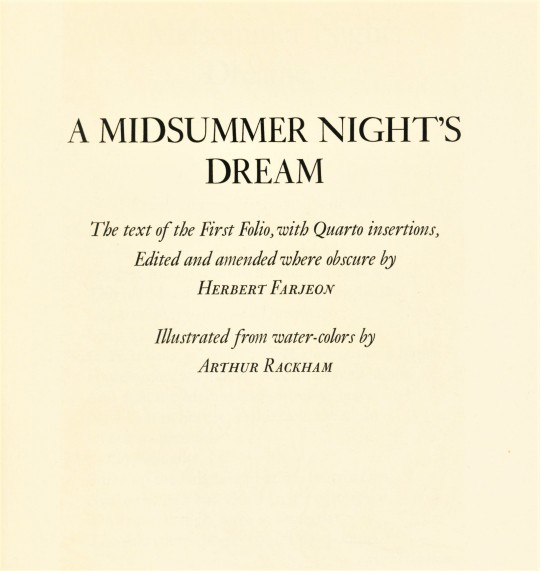



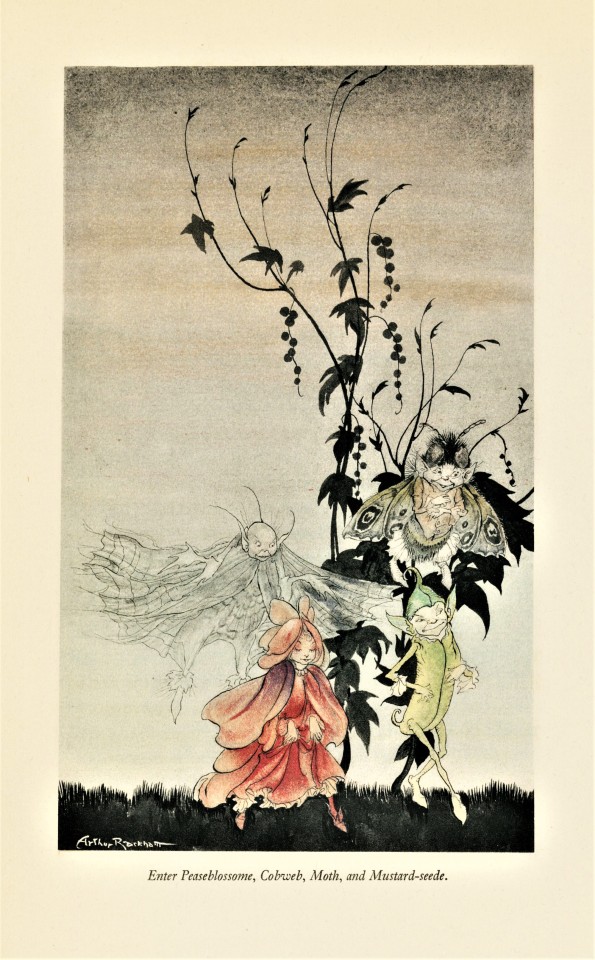


Shakespeare Weekend!
This weekend we are sharing Shakespeare’s comedy, A Midsummer Night's Dream, the twenty-fifth volume of the thirty-seven volume The Comedies Histories & Tragedies of William Shakespeare, published by the Limited Editions Club (LEC) from 1939-1940. This play was likely written between 1595 and 1596, and while it may have been performed before 1600, the first performance known with certainty occurred at Hampton Court on 1 January 1604. The play was entered into the Register of the Stationers' Company on 8 October 1600 by the bookseller Thomas Fisher, who published the first quarto edition later that year. A second quarto was printed in 1619 by William Jaggard, as part of his so-called False Folio. The play next appeared in print in the First Folio of 1623.
This volume was illustrated by the prolific English artist Arthur Rackham (1867-1939). Rackham favored taking on work that would allow him to make “fantastic and grotesque illustrations” which we see in his emotive watercolors for A Midsummer Night’s Dream. Rackham began his career illustrating periodicals but after creating noteworthy illustrations for Rip Van Winkle in 1905, he went on to illustrate nearly one hundred books in his fanciful ink and watercolor style.
The Limited Editions Club took particular care in reproducing Rackham’s work for this volume. Through a process that included delicately adding color over lithographic prints, LEC was able to preserve the spirit and vibrance of Rackham’s work.
The volume was printed in an edition of 1950 copies at the Press of A. Colish. Each of the LEC volumes of Shakespeare’s works are illustrated by a different artist, but the unifying factor is that all volumes were designed by famed book and type designer Bruce Rogers and edited by the British theatre professional and Shakespeare specialist Herbert Farjeon. Our copy is number 1113, the number for long-standing LEC member Austin Fredric Lutter of Waukesha, Wisconsin.

View more Limited Edition Club posts.
View more Shakespeare Weekend posts.
-Jenna, Special Collections Graduate Intern
#Shakespeare weekend#William Shakespeare#Limited Editions Club#LEC#Arthur Rackham#Watercolor illustration#A Midsummer Night's Dream#Press of A. Colish#Bruce Rogers#Herbert Farjeon#lithographs
72 notes
·
View notes
Text
Notes on Anitismo - The Ancient Religion of the Philippines by Isabelo de los Reyes.

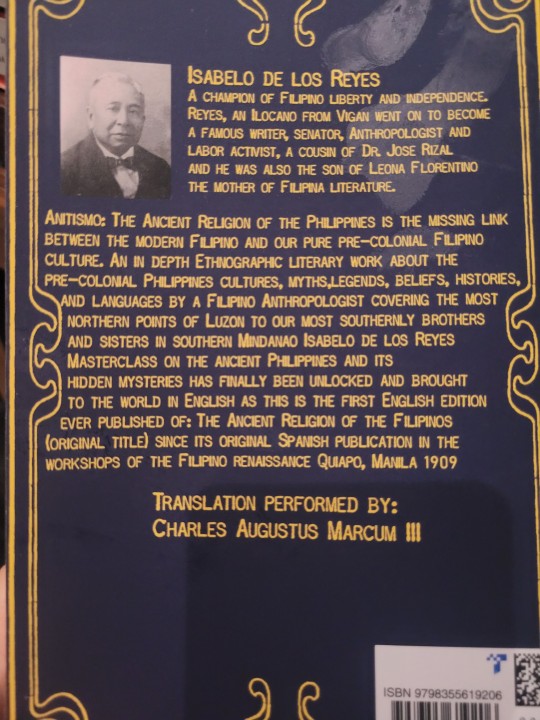
Keep in mind - this was written a while back.
Ancient Chronicles written by the Jesuit hispanic Friars state that at the that the first spaniards set foot in the Philippines from the coast of visayas to Manila there was a considerable population of Muslim converts
This was especially true for Mindanao due to conversion by Islamic teachers from Borneo
De los Reyes argues that because of this, to find native Filipino religion at its purest, we must look to the North
Distinguishing native religion without outside influence such as from Islam, Hinduism, Christianity etc can be tricky
However he argues that the traces of Native Filipino religion can be found in the stories superstitions and advice that belong to various Filipino ethnic groups (Tagalogs, Bicolanos, Zambalenos etc)
From the South of the country in Mindanao to the extreme North like Luzon, De los Reyes argues then native Filipino religion was consistent
This religion was Anitism or the Cult of Anito, meaning souls of the ancestors.
Anitism is not a monolithic religion and hosts a broad pantheon ranging from Gods to animals, nature, elements and space.
The Philippines had its own modern spiritism and De los Reyes argues this may have been the origins of the cults of "Romanist Saints" (Catholic saints) in the Philippines. By this I think he means that Filipino spirituality influenced how Filipinos proceeded with Catholic worship.
The oldest chronicles about the Philippines can be found in various museums and libraries (such as the National Library of Madrid, Covenant of St Augustine in Manila)
We can follow these chronicles, from when the Jesuit Pedro Quirino provided news of religion in the Philippines in 1604, followed by reproductions by others like the Jesuit Colin in 1663 and others such as Fr. Morga, Gonzalez de Mendoza, Aduarte etc.
Fr Morga said that Filipinos practised Anitism in certain regions like Camarines and Cagayan.
Some traditions would say that Manila and its regions were not originally native to the island - they were from Malayan islands and other remote areas.
Before the Spaniards arrived, Islamic teachers from Borneo came to preach and interacted with the locals
Their teachings and beliefs spread quickly throughout the Philippines
Fr. Grijalva writes that they (Filipinos) started adopting their traditions and took on their names.
De Los Reyes argues that Spanish conquistadors' arrival/conquest was delayed because Filipinos were already familiar with various religions and beliefs and also because of the hands of Datu Lapu Lapu. What I believe he is arguing is that Datu Lapu Lapu and the previous exposure Filipinos had to different religions at first delayed Spanish influence from spreading so quickly.
Other islanders who weren't under the control of the government in the Philippines has their beliefs influenced by religious preachers who travelled to them from the Straits of Malacca and the Red Sea.
An account, dated April 20th 1572 (preserved in the archives of India) which is from the conquest of Luzon details "In these towns, closest to the sea, they do not eat any pork, which the moors taught them. But if you ask them, they say they do not know Muhammed or his law." This account was reproduced by Wenceslao Retana.
In actuality, very few Filipinos could understand/read the teachings of the Koran despite the Islamic influence.
In Filipino traditions, reverence and worship was given to nature and the elements, and this was usually consistent throughout the islands.
Native Filipino religion beliefs include elements, animals, stars and ancestors.
Filipino religion in Manila and nearby areas was a mixture or Anitism, Buddhism, Hinduism and Islam brought by the Malays of Borneo.
Vocabulary included Sanskrit and Malay terms such as Bathala, meaning Lord.
However these terms are not used in Northern provinces.
De Los Reyes argues that Itnegs and other mountain tribes conserved and maintained the purest form of Filipino religion
In the Ilocos, Cagayan, Isabela and other provinces of Northern Luzon, native Filipino religion was more prevalent
Hindus and Buddhists converted many in Java and Malaysia.
However Muslim influence became dominant in 1478 - 60 years before the Dutch invasion.
According to Javanese legends, Hindus arrives in Java 78 years before Christ.
The first Malays came from the Minangkabau river region to establish cities in Malacca , Ojohor and Singapore in the 12th century, as per Malacca records.
In the 13th, 14th and 15th centuries, there were various Malaysian emigrations reaching the Philippines
De Los Reyes argues that Filipinos may have also populated the islands of Malaysia, and emigrations could have originated from strong winds coming down from the North.
The first Spaniards found the son of Lakandula, King of Manila, when they went to Borneo.
The emperor's master of ceremonies from Japan (Mr Fujita) argued that emigration likely came from the north and that Filipinos may have some relations to the Japanese.
According to Geographers and Historians of the Mariana Islands, what De Los Reyes calls the "know it all Spanish" - had no idea about interesting ruins found in Oceania, one of which was a prehistoric statue that was being held in the British museum.
He argues there may be hidden megaliths, artefacts, and remnants of lost civilisation in the Philippines, as seen in various locations such as : Butacan caves, Pangibalon Hill, Madias de Iloilo and Nasso.
#Philippines#pre colonial philippines#Filipino#Filipino history#Anitism#Filipino religion#Pinoy#Isabelo de los Reyes#History#Asia#Asian history#South east Asian history#Religion#ancient religion#South east asia#Colonialism#spanish colonial#Spanish colonialism#Philippines history#Philippine history#Anitismo#Keep in mind this was written a while ago so some terms may be outdated#I've tried to interpret some tricky parts the best I could#My ass who is from the Northern Philippines 🗿
66 notes
·
View notes
Text
An AMENDED Rundown on the Absolute Chaos That is First Quarto Hamlet
O, gather round me, my dear Shakespeare friends
And let me tell to ye a tale of woe.
It was a dark and drizzly winter night,
When I discovered my life was a lie...
This tale is a tragedy, one of Shakespeare sources turned into gardening websites, "misdated" quartos, and failed internet archives. It is also a story of the quarto itself, an early printing of our beloved Danish Prince's play, including an implied Hamlet/Horatio coffee date, weird and extremely short soliloquies, and Gertrude with a hint of motivation and autonomy.
But let us start from the beginning. Long ago, in the year of our lord 2022, I pulled a Christmas Eve all-nighter to bring you this post: https://www.tumblr.com/withasideofshakespeare/704686395278622720/a-rundown-on-the-absolute-chaos-that-is-first?source=share
It was popularish in Shakespeare circles, which is why I am amending it now! I returned to it tonight, only to discover a few problems with my dates and, more importantly, a mystery in which one of my sources miraculously turned into a link to a gardening website...
Anyhow, let us begin with the quarto!
TL;DR: Multiple versions of Hamlet were printed between 1603 and 1637 (yes, post-folio) with major character and plot differences between them. The first quarto (aka Q1) is best known for its particular brand of chaos with brief soliloquies, an extra-sad Hamlet, some mother-son bonding, weird early modern spelling, and deleted/adapted scenes with major influences on the plot of the play!
A long rundown is included below the cut, including new and improved sources, lore, direct quotes, and my own interpretations. Skip what bores you!
And continue... if thou darest!
What is the First Quarto? Actually, what is a quarto?
Excellent questions, brave Hamlet fan!
A quarto is a pamphlet created by printing something onto a large sheet of paper and then folding it to get a smaller pamphlet with more pages per big sheet (1).
First Quarto Hamlet was published in 1603 and then promptly lost for an entire two centuries until it was rediscovered in 1823 in the library of Sir Henry Bunbury. Rather than printed from a manuscript of Shakespeare, Q1 seems like it may be a memorial reconstruction of the play by the actor who played Marcellus (imagine being in a movie, memorizing the script to the best of your ability, writing it down, and then selling "your" script off to the print shop), but scholars are still out on this (2).
Are you saying that Hamlet comes with the stageplay equivalent of a “deleted scenes and extra credits” movie disc?
Yep, pretty much! In fact, there are even more of these! Q2 was printed in 1604 and it seems to have made use of Shakespeare's own drafts, and rather than being pirated like Q1, it was probably printed more or less with permission. Three more subsequent quartos were published between 1611 and 1637, but they share much in common with Q2.
The First Folio (F1) was published in 1623 and its copy of Hamlet was either based on another (possibly cleaner but likely farther removed from Shakespeare's own text) playhouse manuscript (2, 3). It was an early "collected works" of sorts--although missing a few plays that we now consider canon--and is the main source used today for many of the plays!
The versions of the play that we read usually include elements from both Q2 and F1.
So... Q1? How is it any different from the version we all know (and love, of course)? What do the differences mean for the plot?
We’ll start with minor differences and build up to the big ones.
Names and spellings
Most of the versions of Shakespeare's plays that we read today have updated spellings in modern English, but a true facsimile (a near-exact reprint of a text) maintains the early modern English spellings found in the original text.
For example, here is the second line of the play transcribed from F1:
Francisco: Nay answer me: stand and vnfold your selfe.
For the most part, however, the names of the characters in these later versions (ex: F1) are spelled more or less how we would spell them today. This is not so in Q1.
Laertes is “Leartes”, Ophelia is “Ofelia”, Gertrude is “Gertred” (or sometimes “Gerterd”), Rosencrantz is “Rossencraft”, Guildenstern is “Gilderstone”, and my favorite, Polonius gets a completely different name: Corambis.
(This goes on for minor characters, too. Sentinel Barnardo is “Bernardo”, Prince Fortinbras of Norway is “Fortenbrasse”, Voltemand and Cornelius--the Danish ambassadors to Norway--are “Voltemar” and “Cornelia” (genderbent Cornelius?), Osric doesn’t even get a name- he is called “the Bragart Gentleman”, the Gravediggers are called clowns, and Reynaldo (Polonius’s spy) gets a whole different name--“Montano”.)
2. Stage directions
Some of Q1's stage directions are more detailed and some are simply non-existent. For instance, when Ophelia enters singing, the direction is:
Enter Ofelia playing on a Lute, and her haire downe singing.
But when Horatio is called to assist Hamlet in spying on Claudius during the play, he has no direction to enter, instead opting to just appear magically on stage. Hamlet also doesn't even say his name, so apparently his Hamlet sense was tingling?
3. Act 3 scene reordering
Claudius and Polonius go through with the plan to have Ophelia break up with Hamlet immediately after they make it (typically, the plan is made in early II.ii and gone through with in III.i, with the players showing up and reciting Hecuba between the two events). In this version, the player scene (and Hamlet’s conversation with Polonius) happen after ‘to be or not to be’ and ‘get thee to a nunnery.’ I’m not sure if this makes more or less sense. Either way, it has a relatively minimal impact on the story.
4. Shortened lines and straightforwardness
Many lines, especially after Act 1, are significantly shortened, including some of the play's most famous speeches.
Laertes’ usually long-winded I.iii lecture on love to Ophelia is shortened to just ten lines (as opposed to the typical 40+). Polonius (er... Corambis) is still annoying and incapable of brevity, but less so than usual. His lecture on love is also cut significantly!
Hamlet’s usual assailing of Danish drinking customs (I.iv) is cut off by the ghost’s arrival. He’s still the most talkative character, but his lines are almost entirely different in some monologues, including ‘to be or not to be’! In other spots, however, (ex: get thee to a nunnery!) the lines are near-identical. There doesn’t seem to be much rhyme or reason to where things diverge linguistically, except that when Marcellus speaks, his lines are always correct. Hm...
5. The BIG differences: Gertrude’s promise to aid Hamlet in taking revenge
Act 3, scene 4 goes about the same as usual with one major difference: Hamlet finishes off not with his usual declaration that he’s to be sent for England but with an absolutely heart-wrenching callback to act 1, in which he echoes the ghost’s lines and pleads his mother to aid him in revenge. And she agrees. Here is that scene:
Note that "U"s are sometimes "V"s and there are lots of extra "E"s!
Queene Alas, it is the weakenesse of thy braine,
Which makes thy tongue to blazon thy hearts griefe:
But as I haue a soule, I sweare by heauen,
I neuer knew of this most horride murder:
But Hamlet, this is onely fantasie,
And for my loue forget these idle fits.
Ham. Idle, no mother, my pulse doth beate like yours,
It is not madnesse that possesseth Hamlet.
O mother, if euer you did my deare father loue,
Forbeare the adulterous bed to night,
And win your selfe by little as you may,
In time it may be you wil lothe him quite:
And mother, but assist mee in reuenge,
And in his death your infamy shall die.
Queene Hamlet, I vow by that maiesty,
That knowes our thoughts, and lookes into our hearts,
I will conceale, consent, and doe my best,
What stratagem soe're thou shalt deuise.
Ham. It is enough, mother good night:
Come sir, I'le prouide for you a graue,
Who was in life a foolish prating knaue.
Exit Hamlet with [Corambis/Polonius'] dead body.
(Internet Shakespeare, Source #4)
Despite having seemingly major consequences for the plot, this is never discussed again. Gertrude tells Claudius in the next scene that it was Hamlet who killed Polonius (Corambis, whatever!), seemingly betraying her promise.
However, Gertrude’s admission of Hamlet’s guilt (and thus, betrayal) could come down to the circumstance she finds herself in as the next scene begins. There is no stage direction denoting her exit, so the entrance of Claudius in scene 5 may be into her room, where he would find her beside a puddle of blood, evidence of the murder. There’s no talking your way out of that one…
6. The BIGGEST difference: The added scene
After Act 4, Scene 6, (but before 4.7) comes this scene, in which Horatio informs Gertrude that Hamlet was to be executed in England but escaped:
Enter Horatio and the Queene.
Hor. Madame, your sonne is safe arriv'de in Denmarke,
This letter I euen now receiv'd of him,
Whereas he writes how he escap't the danger,
And subtle treason that the king had plotted,
Being crossed by the contention of the windes,
He found the Packet sent to the king of England,
Wherein he saw himselfe betray'd to death,
As at his next conuersion with your grace,
He will relate the circumstance at full.
Queene Then I perceiue there's treason in his lookes
That seem'd to sugar o're his villanie:
But I will soothe and please him for a time,
For murderous mindes are alwayes jealous,
But know not you Horatio where he is?
Hor. Yes Madame, and he hath appoynted me
To meete him on the east side of the Cittie
To morrow morning.
Queene O faile not, good Horatio, and withall, commend me
A mothers care to him, bid him a while
Be wary of his presence, lest that he
Faile in that he goes about.
Hor. Madam, neuer make doubt of that:
I thinke by this the news be come to court:
He is arriv'de, obserue the king, and you shall
Quickely finde, Hamlet being here,
Things fell not to his minde.
Queene But what became of Gilderstone and Rossencraft?
Hor. He being set ashore, they went for England,
And in the Packet there writ down that doome
To be perform'd on them poynted for him:
And by great chance he had his fathers Seale,
So all was done without discouerie.
Queene Thankes be to heauen for blessing of the prince,
Horatio once againe I take my leaue,
With thowsand mothers blessings to my sonne.
Horat. Madam adue.
(Internet Shakespeare, Source #4)
First of all, the implication of Hamlet and Horatio's little date in the city is adorable ("Yes Madame, and he hath appoynted me / To meete him on the east side of the Cittie / To morrow morning.") It reads like they're going out for coffee!
And perhaps more plot relevant: if Gertrude knows of Claudius’s treachery ("there's treason in his lookes"), her death at the end of the play does not look like much of an accident. She is aware that Claudius killed her husband and is actively trying to kill her son and she still drinks the wine meant for Hamlet!
Now, the moment we’ve all been waiting for! My thoughts! Yippee!
On Gertrude:
WOW! I’m convinced that she is done dirty by F1and Q2! She and Hamlet have a much better relationship (Gertrude genuinely worries about his well-being throughout the play.) She has an actual personality that is tied into her role in the story and as a mother. I love Q1 Gertrude even though in the end, there’s nothing she can do to save Hamlet from being found out in the murder of Polonius and eventually dying in the duel. Her drinking the poisoned wine seems like an act of desperation (or sacrifice? she never asks Hamlet to drink!) rather than an accident.
On the language:
I think Q1′s biggest shortcoming is its comparatively simplistic language, especially in 'to be or not to be,' which is written like this in the quarto:
Ham. To be, or not to be, I there's the point,
To Die, to sleepe, is that all? I all:
No, to sleepe, to dreame, I mary there it goes,
For in that dreame of death, when wee awake,
And borne before an euerlasting Iudge [judge],
From whence no passenger euer retur'nd,
The vndiscouered country, at whose sight
The happy smile, and the accursed damn'd.
But for this, the ioyfull hope of this,
Whol'd beare the scornes and flattery of the world,
Scorned by the right rich, the rich curssed of the poore?
The widow being oppressed, the orphan wrong'd,
The taste of hunger, or a tirants raigne,
And thousand more calamities besides,
To grunt and sweate vnder this weary life,
When that he may his full Quietus make,
With a bare bodkin, who would this indure,
But for a hope of something after death?
Which pusles [puzzles] the braine, and doth confound the sence,
Which makes vs rather beare those euilles we haue,
Than flie to others that we know not of.
I that, O this conscience makes cowardes of vs all,
Lady in thy orizons, be all my sinnes remembred.
(Internet Shakespeare, Source #4)
The verse is actually closer to perfect iambic pentameter (meaning more lines have exactly ten syllables and consist entirely of iambs--"da-DUM") than in the Folio, which includes many 11-syllable lines. The result of this, however, is that Hamlet comes across here as considerably less frantic (those too-long verse lines in F1 make it feel like he is shoving words into too short a time, which is so very on-theme for him) and more... sad. Somehow, Q1 Hamlet manages to deserve a hug even MORE than F1 Hamlet!
Nevertheless, this speech doesn't hit the way it does in later printings and I have to say I prefer the Folio here.
On the ending:
The ending suffers from the same effect ‘to be or not to be’ does--it is simpler and (imo) lacks some of the emotion that F1 emphasizes. Hamlet’s final speech is significantly cut down and Horatio’s last lines aren’t quite so potent--although they’re still sweet!
Horatio. Content your selues, Ile shew to all, the ground,
The first beginning of this Tragedy:
Let there a scaffold be rearde vp in the market place,
And let the State of the world be there:
Where you shall heare such a sad story tolde,
That neuer mortall man could more vnfolde.
(Internet Shakespeare, Source #4)
Horatio generally is a more active character in Q1 Hamlet. This ending suits this characterization. He will tell Hamlet’s story, tragic as it may be. It reminds me a bit of We Raise Our Cups from Hadestown. I appreciate that this isn't a request but a command: put up a stage, I will tell this story.
Closing notes:
After over a year, it was due time this post received an update. My main revisions were in regard to source verification. Somehow, in the last year or so, one of my old sources went from linking to a PDF of Q1 to a garden website (???) and some citations were missing from the get-go as a result of this being an independently researched post that involved pulling an all-nighter on Christmas Eve (but no excuses, we need sources!)
I have also corrected some badly worded commentary implying that the Folio's verse is more iambic pentameter-y (it's not; in fact, Q1 tends to "normalize" its verse to make it fit a typical blank verse scheme better than the Folio's does--the lines actually flow better, typically have exactly ten syllables, and use more iambs than Q1's) as well as that the spelling in the Folio is any more modern than those in Q1 (they're both in early modern English; I was mistakenly reading a modernized Folio and assuming it to be a transcription--nice one, 17-year-old Dianthus!) Additionally, I corrected the line breaks in my verse transcriptions and returned the block quotations to their original early modern English, which feels more authentic to what was actually written. A few other details and notes were added here and there, but the majority of the substance is the same.
Overall, if you still haven't read Q1, you absolutely should! Once you struggle through the spelling for a while, you'll get used to it and it'll be just as easy as modern English! If you'd prefer to just start with the modern English, I have also linked a modern translation below (source 5).
And finally, my sources!
Not up to citation standards but very user-friendly I hope...
1. Oxford English Dictionary
2. Internet Shakespeare, Hamlet, "The Texts", David Bevington (https://internetshakespeare.uvic.ca/doc/Ham_TextIntro/index.html)
3. The Riverside Shakespeare (pub. Houghton Mifflin Company; G.B. Evans, et al.)
4. Internet Shakespeare, First Quarto (facsimile--in early modern English) (https://internetshakespeare.uvic.ca/doc/Ham_Q1/complete/index.html)
5. Internet Shakespeare, First Quarto (modern English) (https://internetshakespeare.uvic.ca/doc/Ham_Q1M/index.html)
And here conclude we our scholarly tale,
Of sources, citation, and Christmastime too,
Go read the First Quarto! And here, I leave you.
#shakespeare#hamlet#first quarto#first quarto hamlet#classic literature#revisions#hey look at me#having some scholarly merit#i have so much left to learn#which is a darn good thing#how else would i spend my evenings?#the worst part about this#is that it all started because i thought a got a date wrong#but it turns out i didn't#so HA!#but then i realized i got everything else wrong so....#corrections it is!
29 notes
·
View notes
Note
Hey, can you write something about Azriel and reader decided to go on a vacation and they spend the most romantic quality time with each other....like walking around the streets of new town and shopping Azriel buying lots of stuff for reader and ofcourse lotttss of Sex ❤ ( Like their honeymoon phase ) Smutty and fluff 🥺❤
of course, I love the idea. Hope you like the story <;33
Azriel x Reader | Honeymoon
type: fluff/smut
warnings: explicit scenes, so much fluff, soft Azzy, slightly public sex
word count: 1604
*all rights reserved*
~~~~~~~~~~~~~~~~~~~~
“You may be the oh so smart and intelligent spymas—hey!” A loud laugh left you when Azriel pinched your butt. It was your punishment for teasing him. Azriel threw you a wicked grin when you once again interlaced your fingers with his so he could not pinch you again. “That was so very rude, my mate. But as I was trying to say, you might be the smart spymaster, but you are so very wrong. We definitely have to go into this direction to get to the beach!”
Azriel shook his head and pointed into the other direction. “Wrong. We have to go there, my love.”
You had been walking for quite some time, chatting, laughing and simply enjoying each others company. Two days ago you had started your honeymoon—Azriel had taken you to the continent, to Vallahan. You hadn’t known how beautiful this kingdom, its cities and its beaches, were, so still now you found yourself in complete awe while walking through the small allies and streets. Just a month ago you had accepted the bond, the love between your two souls now stronger than ever before. And so was the frenzy. Many times you found it hard to keep your hands from each other or to not rip the other person’s clothes of right where you stood.
A happy, cheery sound escaped you when you jumped up and pointed your finger forward. “Ha!” you expressed, “I told you. It is right there. The sea is right there. See, I told you. Tell me I am the smartest person in the world!”
Azriel laughed loudly, pulled you to him and let his hands fall to your hips. For a long moment he simply stared at you, examined your face and took a deep breath. When he leaned forward he kissed your forehead and smiled against your skin.
“My mate truly is the smartest person alive. I couldn’t feel more honoured or proud to call you mine.” It was then sincerity with which he had said it that made tears creep into your eyes. You arms curled around Azriel’s strong torso in an instant, snuggling your face against his chest. “I love you so much,” you whispered which the shadowsinger returned with similar words. He kissed the top of your head before asking you if you would like to grab something to eat before heading to the beach—you agreed.
While walking to a small restaurant that was situated right next to the beach Azriel decided he had to spoil you with earrings and a necklace. He said that the diamonds on both of them resembled your eyes so much he simply had to buy them for you. Azriel loved the way your eyes started to glow when he said something like this, it made his chest warm and his heart swell.
Neither of you weren’t too hungry so you opted for a small meal, consuming it at the beautiful terrace of the restaurant. Sunset was about to begin and you had an inkling that Azriel wanted to watch it on the beach with you.
“Are you happy, my love?” you questioned when you finished your meal and brushed your hand over your mate’s.
Azriel smiled and nodded his head. “I couldn’t be happier.” Leaning over the table you quickly pecked his lips before Azriel paid and the two of you go up. You didn’t get a chance to leave the restaurant, Azriel stopped you, tugging on your wrist to come closer to him.
Azriel pulled you with your back against his chest, the both of you now staring out at the sea, the sinking sun on the horizon, still standing on the small terrace. Gods, it was beautiful, you thought to yourself.
“It is stunning,” you whispered. Azriel kissed your neck, his hand clasping yours in front of your body. “Not nearly half as stunning as you are.” His lips descended, moving lower to your shoulder where he bit down softly.
“Az,” you murmured, feeling your toes curl and eye lids getting heavy.
Memories of the previous night, of how Azriel had taken you —first on the couch, later on the floor, then in your bedroom and lastly in the bathtub— flashed your mind and made it hard to breathe for a moment.
“Thinking about this morning?” Azriel whispered against the shell of your ear and in an instant all your thoughts went to that morning. You had started off with making your mate feel good, kneeling down in front of the breakfast table, devouring your mate. Later Azriel had made love to you on the table and then against the wall. He had promised you more of that in that evening, but something about how his body already moved against yours, how his scent started to change, told you that you would not have to wait until tonight until you returned to your shared place.
“Let’s go down to the beach, shall we?” Humming you dipped your chin. Yeah, you would like that a lot. With entangled fingers your made your way into the still warm sand, slowly strutting towards the sea. There were hardly any people left when Azriel guided you over the beach, nearing a little passageway that would lead you to a closed-off bay.
The sand was still slightly warm under your feet, you had taken off your shoes earlier.
“Have you ever made love in the sand, my beautiful mate?”
You giggled at the spymaster’s question, your heart starting to beat faster when colour crept into your cheeks. “No,” you answered and smiled sheepishly.
Azriel brushed his thumb over your cheek, a grin spreading from ear to ear. “I think we need to change that. Would you like that?”
You bowed your head and bit down on your lip, knowing it would drive your mate crazy. “I would love that a lot. But isn’t it dangerous, that we get caught?”
“It is nearly fully dark outside, so no, I don’t think it is dangerous. But if you feel uncomfortable with it we can also head home?”
To that you shook your head. You wanted it. And you wanted him. “No, I want it. Here and now!”
Azriel seemed pleased about your answer, his hands sliding to your neck so he could bring you in for a kiss. His lips closed over yours in a passionate kiss, tongue teasing your lips, his mouth tasting yours. Azriel hummed into the kiss, his hand softly stroking down your sides to the hem of your dress. He tugged on it until you lifted your arms and only shortly broke the kiss so Azriel could take the piece of clothing off. His shirt followed and so did his pants which you skillfully untied and then let drop into the sand. After stepping out of them and his underwear, Azriel placed his shirt on the ground and sat down on it. You looked down at your so very naked and utterly beautiful mate, large wings draped in the sand, broad shoulders squared, his strong thighs waiting for you to finally sit down on them. “This is reckless,” you expressed while climbing over your mate’s lap and sitting down not yet sinking down on his already rigid length but rather sitting down a bit lower on his legs. “We don’t have to do this. I already told you that we—ugh, fuck—“
You softly stroked his proud length, fingers curling tightly around him while your gaze never left his. “I said it was reckless, not that I didn’t want it.” You squeezed him lightly, making Azriel groan low in his throat. Shifting on his thighs and lifting yourself up you finally let yourself sink down on him, your nails digging into your mate’s shoulders while you both groaned at the feeling of him sliding into you. Finally fully seated you wasted no moment before starting to rock your hips against your mate’s. Your knees, braced on either side of your mate, dug into the sand, one of your arms curled around Azriel’s neck the other started toying with his wing. Cauldron, how Azriel adored wing play. He growled lowly, groaned and thrusted his hips up, hitting the spot deep inside of you. He did not even try to keep his thrusts shallow, letting you ride him, letting you scream curses and his names. Your mate’s shadows played with your nipple, Azriel’s thumb rubbing the bundle of nerves, bringing you closer and closer to the edge. “Say that you are mine and only mine,” Azriel commanded and softly bit down on your neck.
"I am yours, fully and forever yours, Azriel!”
You felt him twitch inside of you, knowing he was close, and let your nail scrape over the vein leading up to his talon. Azriel threw his head back, growling from the somewhere deep in his throat. You came simultaneously, riding out your heights together before falling back into the sand, holding on tightly to each other.
“Best fucking time of my life. I can’t tell you enough times how much I love you. I cannot even put into words how much I love you,” Azriel said against your head, his soft lips brushing your hair.
“I can only return it. You are the best thing in my life.”
tags: @juulle987 @marimorena06 @danikasthings @younxii @nightcourtwritings @mrofontaine @lunalilyf @whor-3-crux @tired-all-the-time @anni-was-here @ummmmmwat @azbracadabra @j-pendragonx @hollyismentallyillhelp @famousbasementpainter @bsenpai @lena-davina @red-highlady @thesugatoyourtae @azrielsbitxh @cityofidek @moony-thoughts @wrensical003
246 notes
·
View notes
Text

Gottfried Honegger, Computerzeichnungen, in collaboration with ETH Zürich [CDC 1604-A mainframe + app. in FORTRAN programmed by Beat Kleiner], 1970 [© Gottfried Honegger Estate]

Exhibition: Max Frisch & Gottfried Honegger: Der Zufall hat es gut gemeint, Max Frisch-Archiv an der ETH-Bibliothek / ETH-Bibliothek / ETH Zürich, Department of Mathematics, Zürich, May 11, 2017 – September 29, 2017 [Galerie Römerapotheke]
#art#drawing#computer art#computer technology#computer drawing#plotter drawing#programming#geometry#gottfried honegger#max frisch#beat kleiner#max frisch archiv an der eth bibliothek#eth bibliothek#galerie römerapotheke#1970s#2010s
26 notes
·
View notes